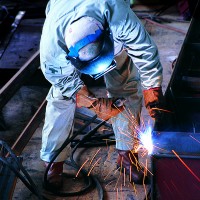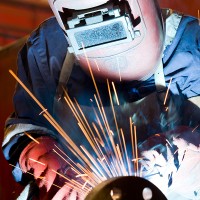Welder
A welder is a tradesman who welds materials, such as plastics or metals, together. Welders have excellent attention to detail and good dexterity to go along with technical knowledge of both the best practices in the field and about the materials being joined. While a career in welding can be dangerous and usually involves early mornings and long hours, it can be very rewarding.
Education
 To become a welder, you need to first finish your high school education. Then you will want to find a trade school or community college that offers an apprenticeship or some kind of formal training in the welding profession. The Tulsa Welding School (https://www.weldingschool.com/) and Hobart Institute of Welding Technology (https://www.welding.org/) are two of the best welding programs in the United States. In almost all welding programs, courses are taught by certified teachers – either professional welding teachers or former industry professionals. Class sizes are usually small, meaning you can get one on one teacher-student instruction. Most welding schools offer job placement assistance to their students, which is a major asset. Most schools will host business visits, allowing companies to recruit from the student body. This makes finding a job and beginning a career much easier for students. Once you complete your program, you can become a certified welder by passing an exam. With a CW, you will be qualified for numerous welding jobs in almost any field you desire.
To become a welder, you need to first finish your high school education. Then you will want to find a trade school or community college that offers an apprenticeship or some kind of formal training in the welding profession. The Tulsa Welding School (https://www.weldingschool.com/) and Hobart Institute of Welding Technology (https://www.welding.org/) are two of the best welding programs in the United States. In almost all welding programs, courses are taught by certified teachers – either professional welding teachers or former industry professionals. Class sizes are usually small, meaning you can get one on one teacher-student instruction. Most welding schools offer job placement assistance to their students, which is a major asset. Most schools will host business visits, allowing companies to recruit from the student body. This makes finding a job and beginning a career much easier for students. Once you complete your program, you can become a certified welder by passing an exam. With a CW, you will be qualified for numerous welding jobs in almost any field you desire.
Job Description
As a welder, you will be required to perform many duties including the following:
- Complete your work duties while safely operating working equipment
- Weld spare parts in various directions such as vertical or horizontal
- Igniting a flame while welding to weld part of a metal structure
- Clamping, tack-welding, bolting, heat-bending, holding or grinding spare parts as required to create a final product while satisfying the technical requirements
- Identifying any faults in equipment or machinery and notifying the supervisors
- Control the process of welding, fitting and burning to avoid problems such as expansion, distortion, or overheating
- Being in charge of setting up necessary equipments and tools for welding jobs (including a gas metal arc or shielded metal arc)
These are just some of the many duties you may perform daily as a welder.
Pros & Cons
 One of the biggest pros of welding is the job variety. Although most welding jobs are in the field of manufacturing, the skill of welding can be applied in many industries including auto making, construction, engineering and shipbuilding. Welders can transfer between industries with relative ease because their knowledge is easily transferable. According to the Bureau of Labor Statistics, there are many job prospects available for welders, and the chance for advancement is high with some additional training. Welding can be an unhealthy and dangerous occupation however, if the work is not done with the proper safety precautions. Most welding procedures involve an open flame or electric arc, and thus the risk of burns is high. A medical condition known as “arc eye” can occur due to the brightness of the weld area. “Arc eye” can cause the cornea to inflame and can even burn the retinas of the eyes. Welders are also frequently exposed to particulate matter and dangerous gases, which can cause medical conditions such as metal fume fever to occur. It is also a physically demanding job, which can take a toll on the body over time and result in chronic pain.
One of the biggest pros of welding is the job variety. Although most welding jobs are in the field of manufacturing, the skill of welding can be applied in many industries including auto making, construction, engineering and shipbuilding. Welders can transfer between industries with relative ease because their knowledge is easily transferable. According to the Bureau of Labor Statistics, there are many job prospects available for welders, and the chance for advancement is high with some additional training. Welding can be an unhealthy and dangerous occupation however, if the work is not done with the proper safety precautions. Most welding procedures involve an open flame or electric arc, and thus the risk of burns is high. A medical condition known as “arc eye” can occur due to the brightness of the weld area. “Arc eye” can cause the cornea to inflame and can even burn the retinas of the eyes. Welders are also frequently exposed to particulate matter and dangerous gases, which can cause medical conditions such as metal fume fever to occur. It is also a physically demanding job, which can take a toll on the body over time and result in chronic pain.

